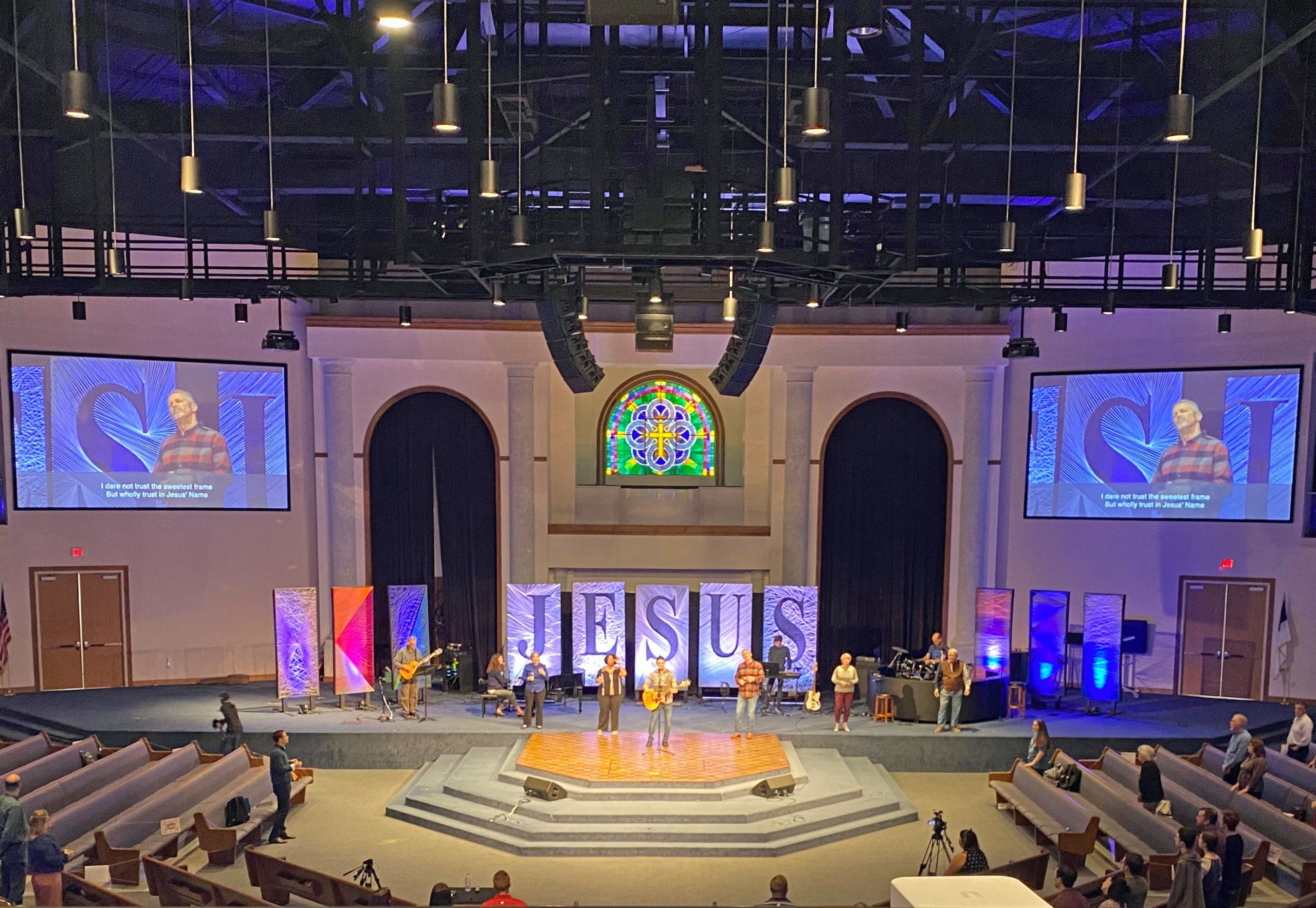Editor’s Note: This article focusing on how to set up church speakers originally published on April 12, 2011, with permission from ProSoundWeb. We updated it with additional information as of Oct. 23, 2024.
The location of the main and monitor loudspeakers in a church will have a decided impact on the success of the presentation.
A single source of sound is best for the spoken word, whenever possible. In a perfect world, it’s best practice to place a church’s main loudspeakers in a central cluster above the front edge of the chancel riser.
Church Speakers Considerations: Enunciation and Speech Intelligibility
When we put sound on people, it is largely absorbed and only minimal reflections continue elsewhere in the room. When the pattern coverage is poorly designed, putting acoustic energy on highly reflective surfaces such as walls, floors and ceilings, the reflected sound can pass the listener’s ears several times, creating a lack of enunciation and speech intelligibility.
A properly designed central cluster allows the sound to reach the listener only once, thereby creating the most concise possible listening situation.
Related: A Guide to House of Worship Lighting Design
But many churches have physical limitations such as low ceilings or tall crosses that require an alternate consideration.
Alternative for Central Cluster
When forced to consider an alternate placement, the choice is usually left side and right side. It’s important to remember that sound will arrive at two different time intervals to people seated along the sides, so we must attempt to select loudspeakers with a narrower coverage pattern.
The goal is to put sound on people at the left with the left speaker and on people at the right with the right speaker, with as little acoustic energy crossing over the middle as possible.
How High Should Church Speakers be Hung?
Generally speaking, loudspeakers should be flown as high as possible (do not exceed 18-22 feet) in order to increase their distance from the front pew.
If the room has extremely low ceilings, we can arrive at a condition where people seated at the front are complaining that it is too loud, while the people at the rear are commenting that the sound needs to be turned up. In such an instance, turn the system down to a comfortable level and hang a second and even third set of loudspeakers perhaps every 25-30 feet as we grow in distance from the chancel.
Because sound traveling through the air takes time, the second set of loudspeakers will need to use a time delay so that the sound traveling from the chancel coincides perfectly with the sound emanating from the second set of loudspeakers.
A third set of loudspeakers will have to be delayed at yet a different setting to coincide with the sound emanating from the first two sets of loudspeakers.
In this manner, all sound source material reaches the ears of the listener at the exact same moment in time, regardless of how far back they are seated in the room, thereby maintaining speech intelligibility.
Though a church may have adequate ceiling height, if the room is very deep, it’s still advisable to use multiple loudspeaker placements on delay lines. Even if the chancel mains could be turned up loud enough to be heard at the back of the room, the sense of distance is audible (due to wall and ceiling reflections) and intelligibility is again adversely affected.
How to Minimize Feedback on Church Speakers
Despite the general public’s degree of sophistication in regards to quality audio, it’s not commonly understood that microphones need to be out of the live sound field whenever possible to minimize feedback and annoying lingering overtones.
Keep loudspeaker enclosures in front of the mics, not behind them. Almost all pastors wear wireless mics, and many like to move about the room while speaking. A good church sound operator will be able to provide equalization so this may be done.
Church Speakers: Keep Monitor Sound Confined to Chancel Riser
Monitor loudspeakers are a wonderful benefit for the performers using them, but they can have a deleterious effect on the sound.
If the monitors are positioned so that the monitor mix bounces off the back of the chancel and reflects back out to the congregation, it’s now combining at a different time interval with the sanctuary main mix, and we have adversely affected the speech intelligibility we had been striving so hard to create out front.
How Loud Should Monitors Be?
Monitors should be just loud enough to keep the performers comfortable. If the monitors are too loud in relationship to the main loudspeakers, no amount of positioning will help maintain clarity in the general seating area.
Since many praise band players are now middle-aged veterans of once-youthful rock bands, gently remind them that the purpose of the monitor line is to lend support and enunciation so that they may execute the material more perfectly.
If the monitors are intended to provide a studio-perfect mix of all instruments and voices for the listening enjoyment of the players, then the church will need to be blessed with highly experienced and adequately funded audio technicians. Many larger churches in metropolitan areas are able to create this benefit for the praise musicians.










